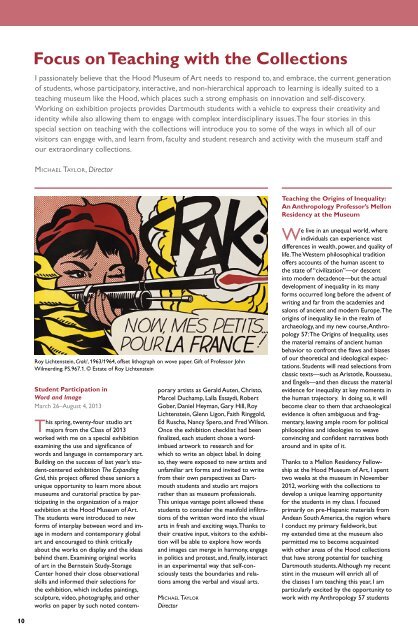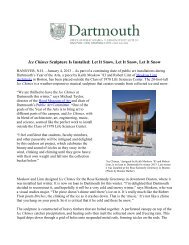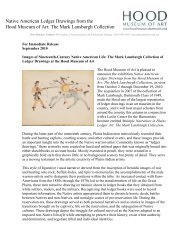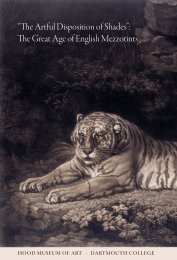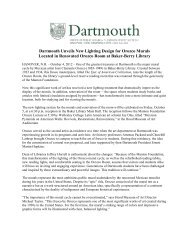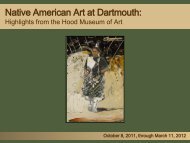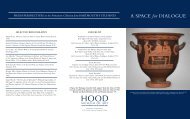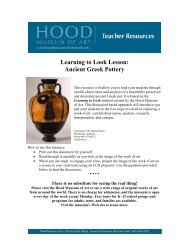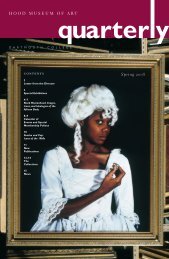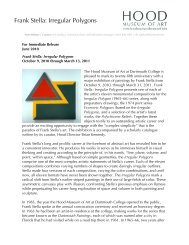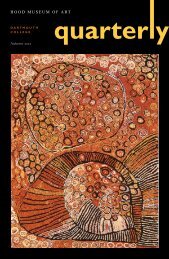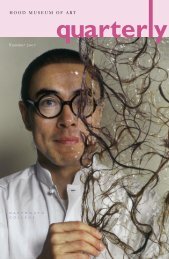Spring 2013 - Hood Museum of Art - Dartmouth College
Spring 2013 - Hood Museum of Art - Dartmouth College
Spring 2013 - Hood Museum of Art - Dartmouth College
- No tags were found...
Create successful ePaper yourself
Turn your PDF publications into a flip-book with our unique Google optimized e-Paper software.
Focus on Teaching with the Collections<br />
I passionately believe that the <strong>Hood</strong> <strong>Museum</strong> <strong>of</strong> <strong>Art</strong> needs to respond to, and embrace, the current generation<br />
<strong>of</strong> students, whose participatory, interactive, and non-hierarchical approach to learning is ideally suited to a<br />
teaching museum like the <strong>Hood</strong>, which places such a strong emphasis on innovation and self-discovery.<br />
Working on exhibition projects provides <strong>Dartmouth</strong> students with a vehicle to express their creativity and<br />
identity while also allowing them to engage with complex interdisciplinary issues. The four stories in this<br />
special section on teaching with the collections will introduce you to some <strong>of</strong> the ways in which all <strong>of</strong> our<br />
visitors can engage with, and learn from, faculty and student research and activity with the museum staff and<br />
our extraordinary collections.<br />
Michael Taylor, Director<br />
Roy Lichtenstein, Crak!, 1963/1964, <strong>of</strong>fset lithograph on wove paper. Gift <strong>of</strong> Pr<strong>of</strong>essor John<br />
Wilmerding; PS.967.1. © Estate <strong>of</strong> Roy Lichtenstein<br />
Student Participation in<br />
Word and Image<br />
March 26–August 4, <strong>2013</strong><br />
This spring, twenty-four studio art<br />
majors from the Class <strong>of</strong> <strong>2013</strong><br />
worked with me on a special exhibition<br />
examining the use and significance <strong>of</strong><br />
words and language in contemporary art.<br />
Building on the success <strong>of</strong> last year’s student-centered<br />
exhibition The Expanding<br />
Grid, this project <strong>of</strong>fered these seniors a<br />
unique opportunity to learn more about<br />
museums and curatorial practice by participating<br />
in the organization <strong>of</strong> a major<br />
exhibition at the <strong>Hood</strong> <strong>Museum</strong> <strong>of</strong> <strong>Art</strong>.<br />
The students were introduced to new<br />
forms <strong>of</strong> interplay between word and image<br />
in modern and contemporary global<br />
art and encouraged to think critically<br />
about the works on display and the ideas<br />
behind them. Examining original works<br />
<strong>of</strong> art in the Bernstein Study-Storage<br />
Center honed their close observational<br />
skills and informed their selections for<br />
the exhibition, which includes paintings,<br />
sculpture, video, photography, and other<br />
works on paper by such noted contemporary<br />
artists as Gerald Auten, Christo,<br />
Marcel Duchamp, Lalla Essaydi, Robert<br />
Gober, Daniel Heyman, Gary Hill, Roy<br />
Lichtenstein, Glenn Ligon, Faith Ringgold,<br />
Ed Ruscha, Nancy Spero, and Fred Wilson.<br />
Once the exhibition checklist had been<br />
finalized, each student chose a wordimbued<br />
artwork to research and for<br />
which to write an object label. In doing<br />
so, they were exposed to new artists and<br />
unfamiliar art forms and invited to write<br />
from their own perspectives as <strong>Dartmouth</strong><br />
students and studio art majors<br />
rather than as museum pr<strong>of</strong>essionals.<br />
This unique vantage point allowed these<br />
students to consider the manifold infiltrations<br />
<strong>of</strong> the written word into the visual<br />
arts in fresh and exciting ways. Thanks to<br />
their creative input, visitors to the exhibition<br />
will be able to explore how words<br />
and images can merge in harmony, engage<br />
in politics and protest, and, finally, interact<br />
in an experimental way that self-consciously<br />
tests the boundaries and relations<br />
among the verbal and visual arts.<br />
Michael Taylor<br />
Director<br />
Teaching the Origins <strong>of</strong> Inequality:<br />
An Anthropology Pr<strong>of</strong>essor’s Mellon<br />
Residency at the <strong>Museum</strong><br />
We live in an unequal world, where<br />
individuals can experience vast<br />
differences in wealth, power, and quality <strong>of</strong><br />
life. The Western philosophical tradition<br />
<strong>of</strong>fers accounts <strong>of</strong> the human ascent to<br />
the state <strong>of</strong> “civilization”—or descent<br />
into modern decadence—but the actual<br />
development <strong>of</strong> inequality in its many<br />
forms occurred long before the advent <strong>of</strong><br />
writing and far from the academies and<br />
salons <strong>of</strong> ancient and modern Europe. The<br />
origins <strong>of</strong> inequality lie in the realm <strong>of</strong><br />
archaeology, and my new course, Anthropology<br />
57: The Origins <strong>of</strong> Inequality, uses<br />
the material remains <strong>of</strong> ancient human<br />
behavior to confront the flaws and biases<br />
<strong>of</strong> our theoretical and ideological expectations.<br />
Students will read selections from<br />
classic texts—such as Aristotle, Rousseau,<br />
and Engels—and then discuss the material<br />
evidence for inequality at key moments in<br />
the human trajectory. In doing so, it will<br />
become clear to them that archaeological<br />
evidence is <strong>of</strong>ten ambiguous and fragmentary,<br />
leaving ample room for political<br />
philosophies and ideologies to weave<br />
convincing and confident narratives both<br />
around and in spite <strong>of</strong> it.<br />
Thanks to a Mellon Residency Fellowship<br />
at the <strong>Hood</strong> <strong>Museum</strong> <strong>of</strong> <strong>Art</strong>, I spent<br />
two weeks at the museum in November<br />
2012, working with the collections to<br />
develop a unique learning opportunity<br />
for the students in my class. I focused<br />
primarily on pre-Hispanic materials from<br />
Andean South America, the region where<br />
I conduct my primary fieldwork, but<br />
my extended time at the museum also<br />
permitted me to become acquainted<br />
with other areas <strong>of</strong> the <strong>Hood</strong> collections<br />
that have strong potential for teaching<br />
<strong>Dartmouth</strong> students. Although my recent<br />
stint in the museum will enrich all <strong>of</strong><br />
the classes I am teaching this year, I am<br />
particularly excited by the opportunity to<br />
work with my Anthropology 57 students<br />
10


